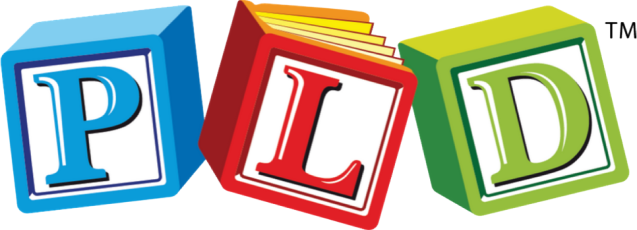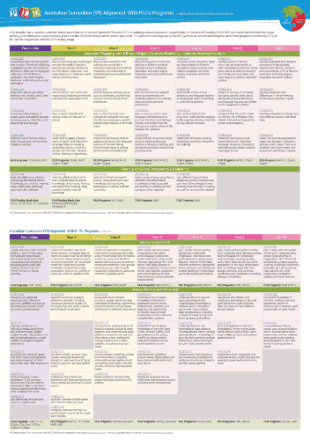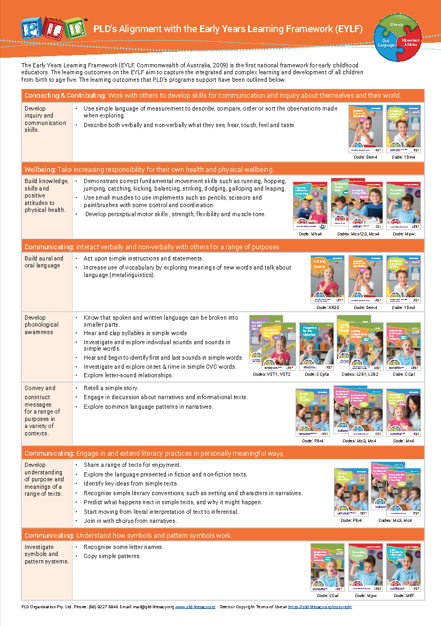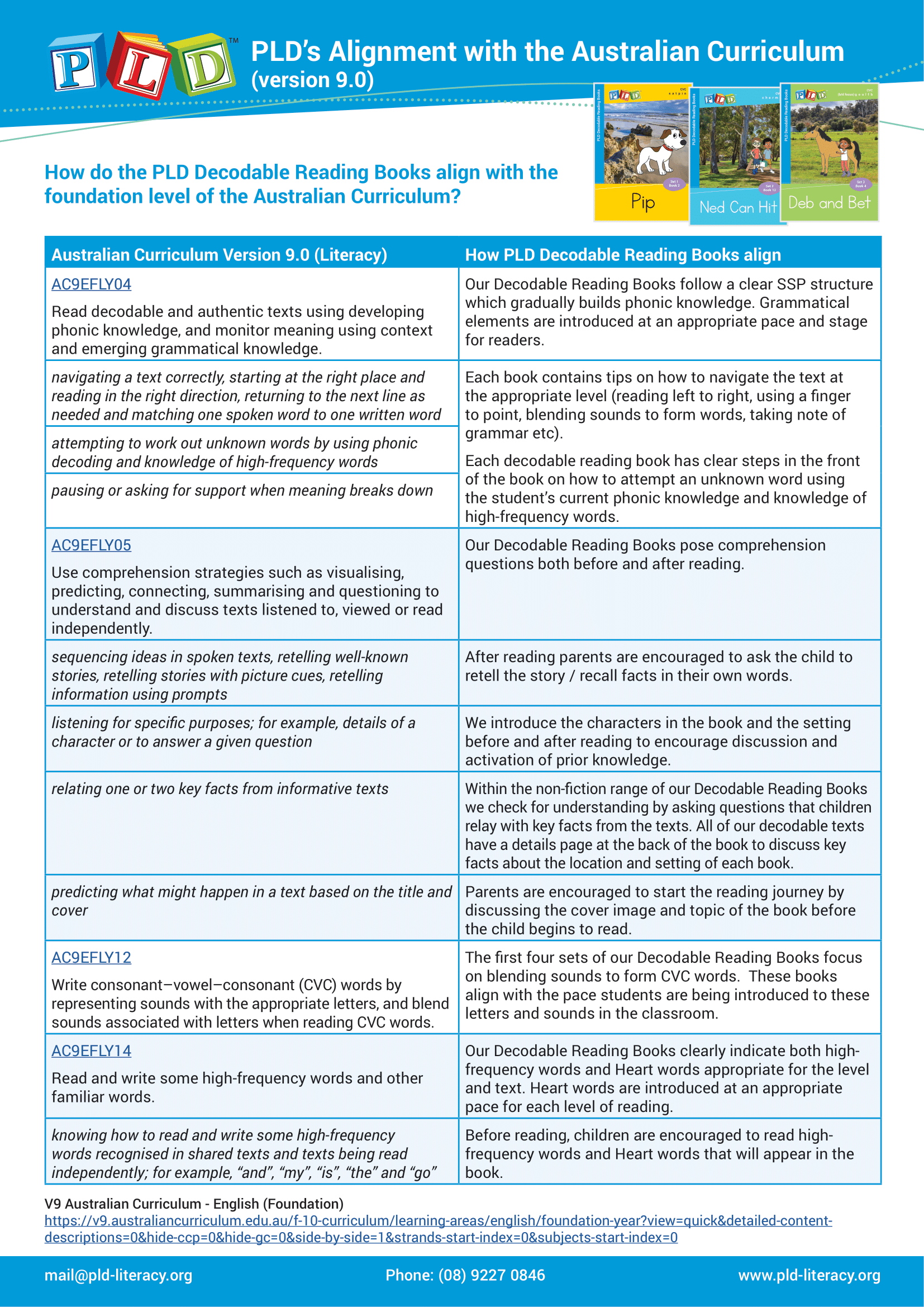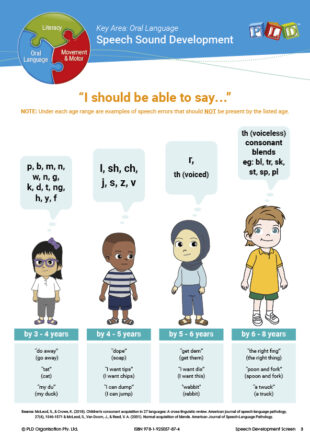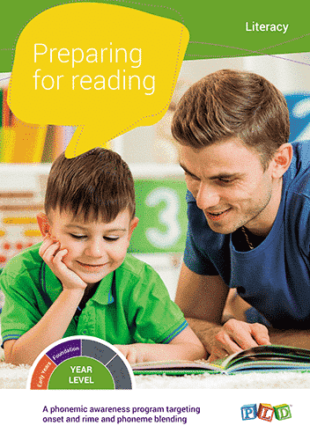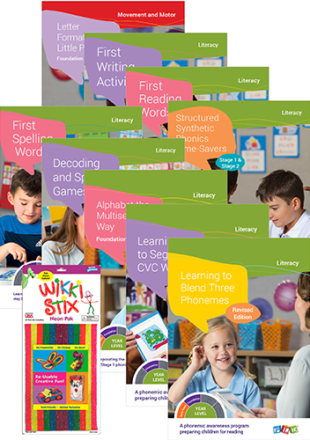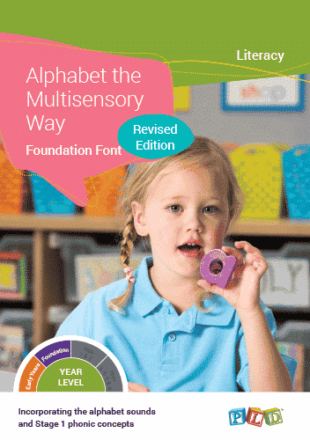-
PLD’s Alignment to the Australian National Curriculum
How does PLD align to the Australian National Curriculum?In the attached download we have outlined where PLD applies to each year level, the content code and descriptor and the related PLD programs.
-
PLD’s Alignment with the Early Years Learning Framework
-
PLD's Decodable Reading Books Alignment with the Australian Curriculum
Alphabet Sound Charts – Foundation Font
$45.00 (inc. $4.09 GST)
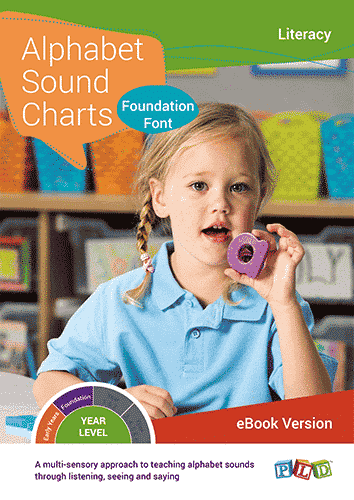

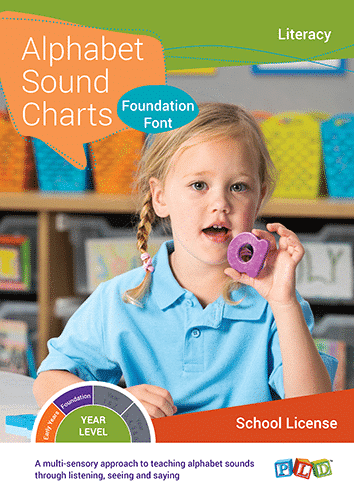
A multi-sensory approach to learning alphabet sounds through listening, seeing and saying.
The Phonic Charts are only available as an eBook.
The hard copy resource has been replaced by Sound Wall Charts.
Children require knowledge of the alphabet in order to learn to read, spell and write. Alphabet sound knowledge is the key to early literacy learning, rather than letter naming. For example:
- In order to read the word ‘dog’ a child must recognise each letter symbol and convert each symbol into the correct sound ‘d’, ‘oh’, ‘g’ and then the child must blend the sounds together (phonemic blending ability).
- In order to spell the basic word ‘cup’ a child must first ‘sound-out’ (or phonemically segment) ‘c’, ‘u’, ‘p’ and then the child must recall and apply in the correct order the alphabet symbols.
As these examples illustrate, alphabetic letter naming does not help a child to blend nor segment the sounds in words. It is their knowledge of the alphabet sounds which allows them to read and spell the words. For this reason, Alphabet sound charts contain bright and attractive charts that represent the alphabet sounds and the mouth position that produces the sound for early literacy learners.
Within this resource, designed by Speech Pathologists for teachers and parents, a multi-sensory approach to teaching the alphabetic letter sounds has been adopted:
- Children see what mouth looks like when producing the alphabet sound (via the visual representation of the mouth on each chart).
- Children kinaesthetically feel what their mouth is doing when they produce the alphabet sounds.
- Children also visually connect a core picture/word with the alphabet sound (e.g. ‘mix’, ‘tiger’ and ‘snake’).
- From an auditory (and phonemic awareness) perspective children identify the initial sound in simple target words (e.g. tiger starts with a ‘t’).
The recommended order of presentation
- Group 1: s, p, n, i, a, t (cards with a yellow border)
- Group 2: m, r, h, e, d, c (cards with a blue border)
- Group 3: f, l, g, o, u b (cards with a green border)
- Group 4: w, j, v, k, z, y, q, x (cards with a red border)
Includes:
- 26 x A4 colour cards
- General information card
This resource is mentioned in the Foundation Teaching Sequence Manual on page 12.
Other phonic posters, available in print or as eBooks, in this series:
Sound Wall Charts:
- Sound Wall Charts for the Early Years (26 A4 coloured charts which focus on the alphabet)
- Sound Wall Charts for Foundation (42 A4 coloured charts which focus on the alphabet and Stage 1 digraphs)
- Sound Wall Charts for Year 1 (49 A4 coloured charts which focus on Stage 1 & Stage 2 digraphs)
- Sound Wall Charts for Year 2 & 3 (71 A4 coloured charts which focus on Stage 1, Stage 2 & Stage 3 digraphs)
What is a sound wall display?
A sound wall is an interactive display of phonic concepts and words that is organised by and/or emphasises individual sounds (phonemes). Commonly there is one wall for consonants and one for vowels.
Sound walls focus on the formation of phonemes which gives young students a structure that helps them understand the foundation of language and written literacy. As we know from current research about the science of reading, children learn to read through the application of orthographic mapping, a speech-to-print process where letters are mapped to known speech sounds. Teachers need to harness this modern understanding by using sound wall displays as a teaching and learning tool in their classrooms to support the process of learning to read and spell.
Alphabet Sound Charts – Foundation Font - eBook
$35.00 (inc. $3.18 GST)



eBooks are solely for use by a single individual user. e.g. An individual classroom teacher. Learn more.
.
The Phonic Charts are only available as an eBook.
The hard copy resource has been replaced by Sound Wall Charts.
Children require knowledge of the alphabet in order to learn to read, spell and write. Alphabet sound knowledge is the key to early literacy learning, rather than letter naming. For example:
- In order to read the word ‘dog’ a child must recognise each letter symbol and convert each symbol into the correct sound ‘d’, ‘oh’, ‘g’ and then the child must blend the sounds together (phonemic blending ability).
- In order to spell the basic word ‘cup’ a child must first ‘sound-out’ (or phonemically segment) ‘c’, ‘u’, ‘p’ and then the child must recall and apply in the correct order the alphabet symbols.
As these examples illustrate, alphabetic letter naming does not help a child to blend nor segment the sounds in words. It is their knowledge of the alphabet sounds which allows them to read and spell the words. For this reason, Alphabet sound charts contain bright and attractive charts that represent the alphabet sounds and the mouth position that produces the sound for early literacy learners.
Within this resource, designed by Speech Pathologists for teachers and parents, a multi-sensory approach to teaching the alphabetic letter sounds has been adopted:
- Children see what mouth looks like when producing the alphabet sound (via the visual representation of the mouth on each chart).
- Children kinaesthetically feel what their mouth is doing when they produce the alphabet sounds.
- Children also visually connect a core picture/word with the alphabet sound (e.g. ‘mix’, ‘tiger’ and ‘snake’).
- From an auditory (and phonemic awareness) perspective children identify the initial sound in simple target words (e.g. tiger starts with a ‘t’).
The recommended order of presentation
- Group 1: s, p, n, i, a, t (cards with a yellow border)
- Group 2: m, r, h, e, d, c (cards with a blue border)
- Group 3: f, l, g, o, u b (cards with a green border)
- Group 4: w, j, v, k, z, y, q, x (cards with a red border)
Includes:
- 26 x A4 colour cards
- General information card
This resource is mentioned in the Foundation Teaching Sequence Manual on page 12.
Other phonic posters, available in print or as eBooks, in this series:
Sound Wall Charts:
- Sound Wall Charts for the Early Years (26 A4 coloured charts which focus on the alphabet)
- Sound Wall Charts for Foundation (42 A4 coloured charts which focus on the alphabet and Stage 1 digraphs)
- Sound Wall Charts for Year 1 (49 A4 coloured charts which focus on Stage 1 & Stage 2 digraphs)
- Sound Wall Charts for Year 2 & 3 (71 A4 coloured charts which focus on Stage 1, Stage 2 & Stage 3 digraphs)
What is a sound wall display?
A sound wall is an interactive display of phonic concepts and words that is organised by and/or emphasises individual sounds (phonemes). Commonly there is one wall for consonants and one for vowels.
Sound walls focus on the formation of phonemes which gives young students a structure that helps them understand the foundation of language and written literacy. As we know from current research about the science of reading, children learn to read through the application of orthographic mapping, a speech-to-print process where letters are mapped to known speech sounds. Teachers need to harness this modern understanding by using sound wall displays as a teaching and learning tool in their classrooms to support the process of learning to read and spell.
eBooks are solely for use by a single individual user. e.g. An individual classroom teacher. Australian Copyright laws prohibit illegal distribution, storage or sharing of this eBook. Usage is tracked and breaches may result in prosecution. Learn more.
If you would like to provide multiple users with access to this resource we suggest selecting the 'Whole School Access' tab at the top of the screen to purchase a School Licence. Learn more.
Alphabet Sound Charts – Foundation Font – School Licence
$135.00 / year (inc. $12.27 GST)



This is a PLD Whole School Licence resource. By purchasing this licence, this program will be accessible as a digital flipbook that will be stored in your secure account on the PLD website. The program will be accessible as a digital flipbook that teachers can access on any device for as long as the licence is active. A School Licence is valid for 12 months from the date of purchase and can be shared with all staff employed at the school. We highly recommend that either the Principal, Deputy Principal or a member of the admin team purchase the School Licence in order to manage the account and its users. For more information, visit our Whole School Licence FAQ.
A multi-sensory approach to learning alphabet sounds through listening, seeing and saying.
Children require knowledge of the alphabet in order to learn to read, spell and write. Alphabet sound knowledge is the key to early literacy learning, rather than letter naming. For example:
- In order to read the word ‘dog’ a child must recognise each letter symbol and convert each symbol into the correct sound ‘d’, ‘oh’, ‘g’ and then the child must blend the sounds together (phonemic blending ability).
- In order to spell the basic word ‘cup’ a child must first ‘sound-out’ (or phonemically segment) ‘c’, ‘u’, ‘p’ and then the child must recall and apply in the correct order the alphabet symbols.
As these examples illustrate, alphabetic letter naming does not help a child to blend nor segment the sounds in words. It is their knowledge of the alphabet sounds which allows them to read and spell the words. For this reason, Alphabet sound charts contain bright and attractive charts that represent the alphabet sounds and the mouth position that produces the sound for early literacy learners.
Within this resource, designed by Speech Pathologists for teachers and parents, a multi-sensory approach to teaching the alphabetic letter sounds has been adopted:
- Children see what mouth looks like when producing the alphabet sound (via the visual representation of the mouth on each chart).
- Children kinaesthetically feel what their mouth is doing when they produce the alphabet sounds.
- Children also visually connect a core picture/word with the alphabet sound (e.g. ‘mix’, ‘tiger’ and ‘snake’).
- From an auditory (and phonemic awareness) perspective children identify the initial sound in simple target words (e.g. tiger starts with a ‘t’).
The recommended order of presentation
- Group 1: s, p, n, i, a, t (cards with a yellow border)
- Group 2: m, r, h, e, d, c (cards with a blue border)
- Group 3: f, l, g, o, u b (cards with a green border)
- Group 4: w, j, v, k, z, y, q, x (cards with a red border)
Includes:
- 26 x A4 colour cards
- General information card
This resource is mentioned in the Foundation Teaching Sequence Manual on page 12.
Other phonic posters, available in print or as eBooks, in this series:
Books: PLD’s books may only be used by the Authorised Purchaser, and the Authorised Purchaser’s students, and only in conjunction with classes taken by the Authorised Purchaser. PLD’s books may be photocopied up to 10% per year for use only by the Authorised Purchaser. The Authorised Purchaser is defined as the original purchaser of the PLD materials.
eBooks: PLD’s eBooks may only be used by the Authorised Purchaser, and the Authorised Purchaser’s students, and only in conjunction with classes taken by the Authorised Purchaser. The Authorised Purchaser is defined as the original purchaser of the PLD eBook. Under the ‘Statutory Educational Licence’ the authorised purchaser can:
- View the eBook as a whole or in part
- Copy the eBook to their personal drive or locally on their device
- Display the eBook on your Interactive Whiteboard, projector or smart TV, for the purpose of teaching the students in their own classroom
- Photocopy or print up to 10% of the eBook per year, for use with the students in their classroom(s).
For copyright purposes, every page of the PLD eBooks will be stamped with the name & email address provided by the purchaser at the time of order. PLD ebooks belong solely to the purchaser and may not be shared with colleagues, parents or anyone else. PLD eBooks must not be uploaded to school servers, intranets or online platforms. Schools wishing to licence PLD eBooks can contact us HERE.
School Licences: A School Licence is a multi-user subscription to a PLD resource, such as a book or program, in a digital and printable format that is accessible via the ‘My Subscription’ section of the PLD website. A School Licence is valid for 12 months from the date of purchase and can be used by an unlimited number of teachers within a school. When bought under a School Licence:
- Resources are accessible in digital, flipbook format, which teachers can access from anywhere, at any time, on any device via the PLD website.
- The resources can be used by any amount of teachers in that school.
- Multiple teachers can access the resources simultaneously.
- The resource is available to print, subject to the standard 10% per year limitation as per Australian Copyright law.
- Updated versions of resources will be automatically accessible to users with a current licence for free, ensuring all users have access to the latest versions of resources.
- Resources are stored centrally and accessed via a secure login account on the PLD website. Thus, all currently subscription resources are accessible in the one convenient place, making resources extremely easy to find. Moreso, the school licence offering eradicates the frustration of lost or misplaced resources and programs which happens often with hardback books.
Additional information can be accessed via the following links:
Books: https://support.pld-literacy.org/en-au/article/plds-printed-electronic-materials-how-can-they-be-used-can-i-share-them-with-a-friendcolleague-9lk4y/
eBooks: https://support.pld-literacy.org/en-au/article/the-pld-ebooks-how-can-they-be-used-what-is-the-copyright-policy-ptfya8/
PLD’s Copyright Policy: https://support.pld-literacy.org/en-au/article/copyright-and-terms-of-use-of-pld-literacy-15tkcer/
ISBN :
9 781925 769135
ISBN :
9 781925 769135

